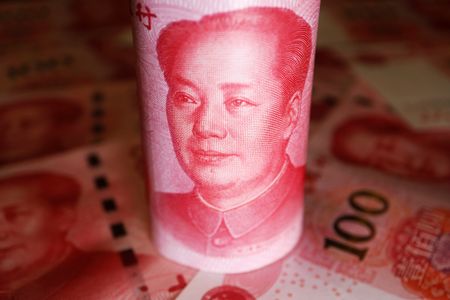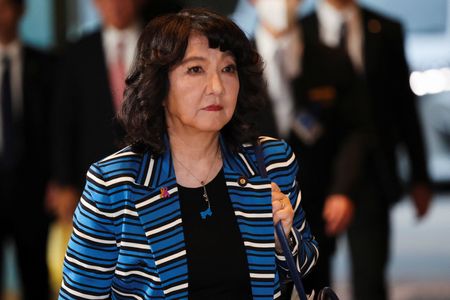(Reuters) -The yuan has shrugged off a trade war, slow growth, rock-bottom interest rates and a slump in foreign investment, to head for its sharpest annual gain since the pandemic year of 2020.
The steady appreciation of the tightly-managed currency has reignited speculation that Beijing is renewing its campaign to drive the yuan’s global use, analysts say.
The People’s Bank of China (PBOC), which manages the currency within a fixed trading band, did not comment when asked about the yuan’s management this year or the strategy behind its strength.
Yet for market participants, the nature of gains on the dollar are telling. Where in 2018, the yuan was a shock-absorber for U.S. trade restrictions and fell about 5%, in 2025 it is nearly 3% stronger.
That has happened because, for months, it has been guided higher almost every morning by the PBOC’s midpoint settings, while at the same time frequent state banks’ dollar buying has capped volatility and steadied its grind higher.
“It’s staying stronger than expected despite escalating U.S. trade actions,” said Kelvin Lam, senior China+ economist at Pantheon Macroeconomics.
“From a strategic optics point of view, China appears keen to project the image of a stable yuan to build international credibility, reminiscent of 1998 when the yuan refused to join the wave of competitive devaluations during the Asian Financial Crisis and cemented its status as a regional anchor.”
Stronger-than-expected daily fixings by the PBOC since last November have gained attention in light of weak economic fundamentals. Benchmark interest rates are well below dollar counterparts. Growth has been held back by anaemic consumption and the capital account showed a $281 billion deficit over 10 months to end October.
At the same time, China’s economic blueprint appears to harden its ambitions for the currency. Having long promised to “prudently promote” yuan internationalisation, the 15th five-year plan published in October drops the word “prudently”.
“Showcasing a strong and stable yuan amid a volatile market environment tends to be a good case for China to promote yuan internationalisation,” said Kiyong Seong, lead Asia macro strategist at Societe Generale.
SEVEN AND BEYOND
The strongest hand behind the yuan has been the central bank, which has encouraged investment bank analysts to expect gains and greater adoption to continue.
“For both economic and non-economic reasons, we believe yuan internationalisation has become a policy priority for the Chinese government and is likely to accelerate meaningfully in the coming years,” analysts at Goldman Sachs said in a note.
Goldman analysts said the authorities’ comfort with its strength has them expecting it to hit 7 per dollar by year-end and keep rising to 6.85 in a year’s time. The yuan traded at 7.1068 per dollar on Monday.
The PBOC has been fixing the midpoint, which allows the spot rate to fluctuate a maximum 2% on either side, firmer than market projections since last November.
The average gap between the official midpoint and Reuters’ market-based estimates stood at 327 pips since April, while yuan adoption has been gaining momentum.
Since the last survey in 2022, this year’s Bank for International Settlements figures show a near 60% increase in the daily turnover in the dollar yuan pair to $781 billion, which is a little over 8% of total daily currency trade.
STORE OF VALUE
The other part of the picture has been steadiness, thanks to what several separate market sources describe as the constant appearance of state banks selling yuan onshore and offshore.
This has kept three-month realised volatility for USD/CNY hovering near decade lows. Analysts say it encourages exporters to gradually sell down some of the roughly $1 trillion pile of dollars on deposit, chipping away at a long-standing risk to yuan stability.
Commercial banks purchased a net $17.7 billion of foreign exchange from clients in October, data shows, a sixth straight month of surplus and suggesting an increase in dollar selling.
To be sure, the signal is complicated by volatile export receipts, and, in any case, yuan strength has been uneven. The yuan has fallen 7.7% this year against the euro and is down 3% against a basket of trading partners’ currencies.
Most market participants also say internationalisation at scale won’t happen until China loosens its control over the flow of capital across its borders – an unlikely move in the near term.
Still, the price and momentum have caught markets’ attention.
“The government’s inclination to keep the yuan value stable while allowing gradual appreciation should gain trust in the yuan as a store of value,” said Shuang Ding, chief economist for Greater China and North Asia at Standard Chartered.
“This intention appears to be supported by China’s trade competitiveness and the authorities’ proven record of managing capital flow volatility.”
(Reporting by Reuters staff in Singapore and Shanghai; Writing by Tom Westbrook; Editing by Jacqueline Wong)











